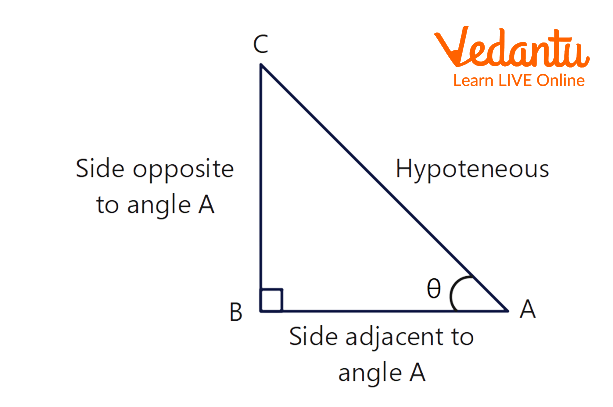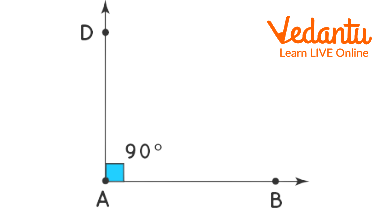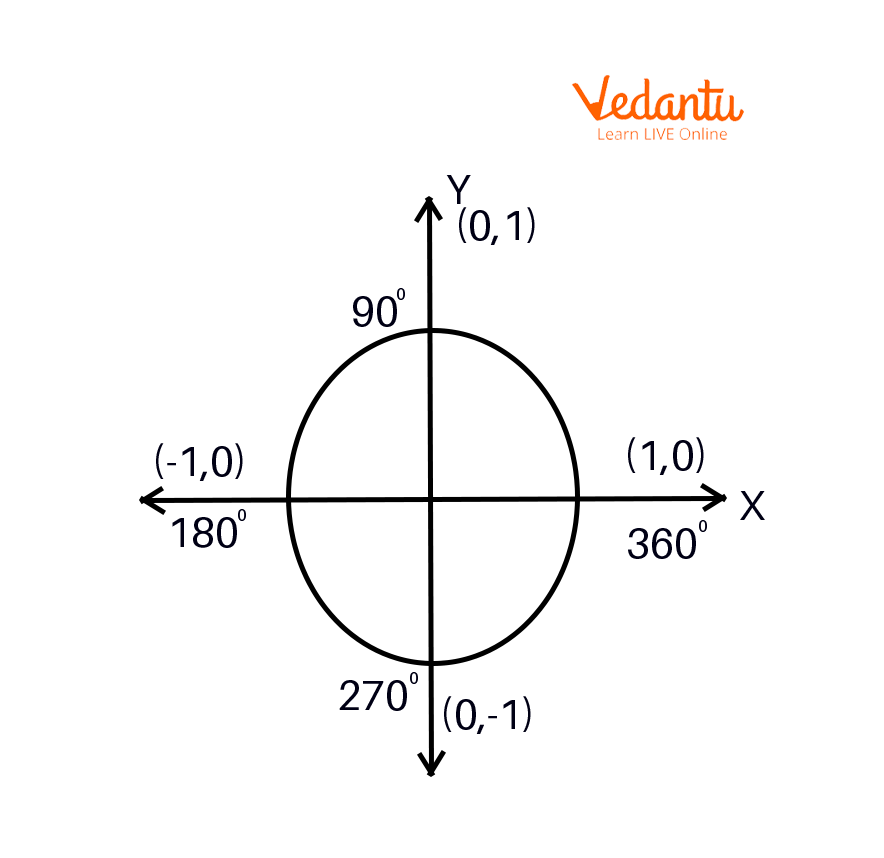




How to Calculate Tan 90 Degrees and Its Importance in Trigonometry
One of the fundamental trigonometric functions and one that is quite frequently employed in trigonometry is the tangent. The ratio of the sine and cosine functions can be used to define the tangent function. The ratio of the perpendicular to the base of the triangle serves as the formula for the tangent function in a right-angled triangle. It can alternatively be written as the cotangent function reciprocal. In this article, we are going to study the Tan $90$ degrees formula, how to find it and what is a $90$ degrees angle.
Tan Definition
The most significant trigonometric function after Sin and Cos is Tan. The opposing side's length divided by the adjacent side's length is the angle's tan function. It is simple to determine the values of these tangent functions using a right-angled triangle. In a right-angled triangle, the side that forms a side of both the angle of intersection and the right angle is known as the adjacent side. In contrast, the side that forms the opposite of the angle of intersection is known as the opposite side and the hypotenuse side is known as the hypotenuse side. Tan gives the slopes of straight lines, for example: the straight line drawn in the x-y coordinate plane. The Tangent can also be represented as tan.

Tangent Function
Tan Formula
For a given right-angled triangle, Tan is defined as the ratio of the opposite side and the adjacent side,
such as $\tan \theta = \dfrac{{BC}}{{AB}}$ and the other formula for tangent function can be written as $\tan \theta = \dfrac{{\sin \theta }}{{\cos \theta }}$ .
To prove this we have,
$\tan \theta = \dfrac{{BC}}{{AB}}$
We can also write,
$\tan \theta = \dfrac{{\dfrac{{BC}}{{AC}}}}{{\dfrac{{AB}}{{AC}}}}$
As, $\sin \theta = \dfrac{{BC}}{{AC}}$ and $\cos \theta = \dfrac{{AB}}{{AC}}$ .
So, using these in the tangent formula, we get
$ \Rightarrow \tan \theta = \dfrac{{\sin \theta }}{{\cos \theta }}$
Thus, we can get the values of tan ratio for the specific angles

Right-angled Triangle
In Triangle we can find the tan value by dividing the opposite and adjacent sides of the triangle where \[\theta \] is the angle of the triangle.
Therefore, tan formulas are $\tan \theta = \dfrac{{\sin \theta }}{{\cos \theta }}$ and $\tan \theta = \dfrac{{BC}}{{AB}}$ .
90-Degrees Angle
An angle of $90$ degrees is created when two straight lines cross perpendicularly. In other words, the angle between two radii of a circle that results in the circumference of the circle being cut off by an arc with a length equal to one-quarter of the circumference; also known as a $90^\circ $ angle or $\dfrac{\pi }{2}$ radian.
Example: The hands of a clock at 3 o’clock and at 12 o’clock.
The four angles of simple geometries like squares and rectangles are always at $90$ degrees. When two lines intersect at a $90$ degree angle, the lines are referred to as perpendicular lines.

90-Degree Angle
What is Tan 90
For tan $90$ degrees, the angle $90$ degree always lies on the positive y-axis and the tangent function is a periodic and odd function, we can represent tan 90 degrees as $\tan \left( {90^\circ + n \times 180^\circ } \right)$, $n \in \mathbb{Z}$. If the question arises, why is tan 90 undefined? Since the outcome is infinite and we cannot define infinity, tan 90 is an indefinite quantity.
Methods to Find Tan 90 Degrees Exact Value
There are two methods to find the tan value, namely
Using Unit circle
Using Trigonometric functions
Using Unit Circle
To find the value of tan $90$ degrees using unit circle:

Unit circle
First we need to rotate ‘$r$’ anticlockwise to form a $90$ degree angle with the positive x-axis. The tan of $90$ degrees equals the y- coordinate $(1)$ divided by x- coordinate $(0)$ of the point of intersection $(0,1)$ of the unit circle and $r$. And tan is represented in the third quadrant of the circle with $360$ degree.
Therefore the value of $\tan 90^\circ = \dfrac{y}{x} = \dfrac{1}{0} = \infty $ .
Using Trigonometric Functions
The tangent function is one of the six primary functions in Trigonometry. The tangent formula is given as tan A $ = $ opposite side divided by the adjacent side.
Tan $90$ degree can also be found by using the sine and cosine terms
Example: $\tan 90^\circ = \dfrac{{\sin 90^\circ }}{{\cos 90^\circ }}$.
Whereas \[{{\sin }^{2}}\theta =1-{{\cos }^{2}}\theta \] which can be written as
\[\sin \theta =\sqrt{1-{{\cos }^{2}}\theta }\] and similarly
\[\cos \theta =\sqrt{1-{{\sin }^{2}}\theta }\] then we can define tan 90 degree by
$\tan 90^\circ = \dfrac{{\sqrt {1 - {{\cos }^2}90^\circ } }}{{\cos 90^\circ }}$ or $\tan 90^\circ = \dfrac{{\sin 90^\circ }}{{\sqrt {1 - {{\sin }^2}90^\circ } }}$ .
Then by using cot function, we can define tan $90$ degree as tan 90 is equal to
$\dfrac{1}{{\cot 90^\circ }}$.
We can use Trigonometric identities to represent tan 90 degrees as $\tan (180^\circ - 90^\circ ) = - \tan 90^\circ $. This means that in the second quadrant, the value of the tangent function will be negative.
$\cot (90^\circ - 90^\circ ) = \tan 90^\circ $. This says that the cotangent function in the very first quadrant will change to the positive tangent value.
$[\cot (90^\circ + 90^\circ ) = - \tan 90^\circ ]$ . This implies that in the second quadrant, the value of the cotangent function will change to negative times the value of the tangent function.
Similarly, we can define tan $90$ degree in many terms with six trigonometric functions for each quadrant system.
Since the $90$ degree always lies on the positive axis of y so the value will be undefined.
Interesting Facts
The word tangent comes from the name tangerine, is “to touch”.
Babylonians invented the measurement of the angle.
The Mesopotamians passed their base-60 numerical system to the ancient Egyptians, who used it to divide the circle into $360$ degrees.
Solved Examples
1. What is the value of tan 90 degrees using the functions sin \[{{90}^{0}}\] and cos \[{{90}^{0}}\]?
Solution:
We know that
$\tan 90^\circ = \dfrac{{\sin 90^\circ }}{{\cos 90^\circ }}$
Substituting the values of sine $90$ degree and cosine $90$ degree in the above equation, we get
$\tan 90^\circ = \dfrac{1}{0} = \infty $ .
2. Find the value of tan $45$ degree using the function sin \[{{45}^{0}}\] and cos\[{{45}^{0}}\]?
Solution:
We know that
$\tan 45^\circ = \dfrac{{\sin 45^\circ }}{{\cos 45^\circ }}$
$ \Rightarrow \tan 45^\circ = \dfrac{{\dfrac{1}{{\sqrt 2 }}}}{{\dfrac{1}{{\sqrt 2 }}}}$
$ \Rightarrow \tan 45^\circ = 1$.
3. What is the value of tan 90 degrees by using cot \[{{90}^{0}}\]?
Solution:
We know that
Tan 90 degree $ = \dfrac{1}{{\cot 90^\circ }}$ .
Where, $\cot 90^\circ = 0$
Then tan 90 degree $ = \dfrac{1}{0} = \infty $ (or undefined).
4. Find tan A with the opposite side $ = 25$ and adjacent side $ = 5$?
Solution:
We know that
Tan A $ = $ opposite side divided by the adjacent side
Tan A $ = \dfrac{{25}}{5}$
Tan A $ = 5$.
Summary
The tangent of the angle is the trigonometric ratio between the adjacent and opposite sides of a right triangle containing that angle. The value of Tan 90 degrees always lies on the positive y-axis, so it is undefined. We also talked about ways to find tan values for any given angle and sides.
Practice Questions
1. Find the Value of Tan B where the opposite side and adjacent side of the functions are 3 and 6.
2. Find the value of Tan 45 degrees by using the function cot 45 degrees.
3. Find the value of Tan 60 degrees by using the function sin \[{{60}^{0}}\] and cos\[{{60}^{0}}\]?
Answers:
1. $\dfrac{1}{2}$
2. $1$
3. $\sqrt 3 $
FAQs on What Is the Value of Tan 90 Degrees?
1. What is the exact value of tan 90 degrees?
The value of tan 90 degrees (or tan π/2) is undefined. This is because the tangent function at this angle involves division by zero, which is a mathematically indeterminate operation.
2. How is the tangent function defined in trigonometry?
The tangent function, abbreviated as 'tan', can be defined in two primary ways:
- In a right-angled triangle: For a given angle θ, tan(θ) is the ratio of the length of the opposite side to the length of the adjacent side.
- Using sine and cosine: For any angle θ, the tangent is the ratio of the sine of the angle to the cosine of the angle. The formula is tan(θ) = sin(θ) / cos(θ).
3. Why is the value of tan 90 degrees undefined?
The value of tan 90° is undefined because its calculation leads to division by zero. Using the identity tan(θ) = sin(θ) / cos(θ), we substitute the known values for 90 degrees: sin(90°) = 1 and cos(90°) = 0. This results in tan(90°) = 1 / 0. Since division by zero is not a valid mathematical operation, the result is considered undefined.
4. How can we prove that tan 90° is undefined using sine and cosine values?
The proof is straightforward using the fundamental trigonometric identity.
- Start with the formula: tan(θ) = sin(θ) / cos(θ).
- Substitute θ = 90° into the formula: tan(90°) = sin(90°) / cos(90°).
- From the standard values of trigonometric functions, we know that sin(90°) = 1 and cos(90°) = 0.
- Substituting these values gives: tan(90°) = 1 / 0.
- As division by zero is mathematically undefined, we conclude that the value of tan 90° is undefined.
5. What does the undefined value of tan 90° represent in terms of a graph or a slope?
In coordinate geometry, the tangent of an angle (tan θ) represents the slope of a line that makes that angle with the positive x-axis. A 90-degree angle corresponds to a perfectly vertical line. The slope of a vertical line is considered undefined because there is no change in the horizontal direction (the 'run' is zero). Therefore, the undefined value of tan 90° geometrically signifies the slope of a vertical line.
6. How does the unit circle help in visualising why tan 90° is undefined?
On a unit circle (a circle with radius 1), any point on the circumference has coordinates (cos θ, sin θ). To find tan 90°, we look at the point on the circle corresponding to a 90° rotation from the positive x-axis. This point is at the very top of the circle, with coordinates (0, 1). Since tan(θ) = y/x = sin(θ)/cos(θ), for 90°, this becomes tan(90°) = 1/0. Visually, you are trying to divide a vertical displacement of 1 by a horizontal displacement of 0, which confirms it is undefined.
7. Is there a difference between 'undefined' and 'infinity' for the value of tan 90°?
Yes, there is a crucial distinction. 'Undefined' means that a value does not exist within the set of real numbers because it results from an invalid operation like division by zero. 'Infinity' (∞) is a concept used in limits to describe a value that grows without bound. While the graph of tan(x) approaches infinity as x gets close to 90° from the left, and negative infinity from the right, at the exact point of 90°, the function has no defined value. Therefore, the correct term for tan 90° is 'undefined'.
8. What is the value of cot 90° and how does it relate to tan 90°?
The value of cotangent 90° (cot 90°) is 0. The cotangent function is the reciprocal of the tangent function (cot θ = 1/tan θ) and can also be defined as cos θ / sin θ.
- Using the ratio: cot(90°) = cos(90°) / sin(90°) = 0 / 1 = 0.
- This relationship highlights why tan 90° is undefined. Since cot 90° = 0, its reciprocal, tan 90°, would be 1/0, which is an undefined expression.























